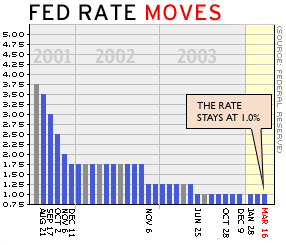NEW YORK (CNN/Money) -
After fretting for months about Alan Greenspan and his band of policy makers at the Fed, U.S. stock markets may actually yawn at what could be a momentous meeting this week. But they'll have plenty of economic news to keep them jumping, still with the Fed firmly in mind.
Federal Reserve policy makers are scheduled to congregate Tuesday to cogitate about the economy and their target for the federal funds rate, an overnight bank lending rate that influences the cost of lending throughout the economy.

Though economists widely expect central bankers to leave the fed funds rate at 1 percent, the lowest level since the Kennedy administration, they also expect big changes to the three-paragraph statement accompanying the Fed decision.
After its most recent policy meeting, in mid-March, the Fed said hiring had "lagged," core consumer prices were "muted" and it could be "patient" about taking its foot off the economy's gas pedal by raising rates.
Since then, however, we've learned that non-farm payrolls grew by a whopping 308,000 in March and that the Fed's favorite inflation measure posted its biggest gain in three years in the first quarter. Fed Chairman Alan Greenspan, meanwhile, has warned that interest rates are set to rise and that the "deflation," or falling prices, everybody feared in 2003 is no longer a threat.
"The stronger data virtually assure significant changes in the Fed's directive this week," Lehman Brothers economists Ethan Harris and Joe Abate wrote in a note to clients on Friday. "The new directive will probably include a grudging acknowledgement of the stronger labor market and inflation statistics."
"The Fed is also likely to drop the 'patient promise' sentence, suggesting that future policy will be dictated by the data," the economists added.
Though higher rates are anathema to stock prices, a Fed warning on Tuesday might not have much of a market impact, since stocks have already weakened in response to the various red lights that have been flashing out warnings of higher rates for several weeks.
After running up above 1,150 in late January, the S&P 500 index has bounced around unhappily, dipping at one point below 1,100 and falling close to that level again on Friday. The Dow Jones industrial average has charted a similar path, while the Nasdaq has suffered a 10-percent drop.
"If you look at the correction that's already occurred in the leadership group, tech, over the past few weeks, it's been pretty severe," said Grace Fey, market strategist with Frontier Capital Management. "I don't expect that there will be a dramatic sell-off on Tuesday -- stocks will go sideways for a while until people become convinced that, while multiples won't expand, the earnings outlook looks pretty good."
But the week also brings blockbuster economic reports: the Institute for Supply Management's closely watched index of national factory activity and, on Friday, the Grandaddy of them all, the Bureau of Labor Statistics' report on April payrolls and unemployment.
Not long ago, only bond traders feared strong economic reports, while stocks welcomed confirmation that the economy was recovering. Now that interest rate fears hold sway in both markets, if this week's data are much stronger than expected, then stocks and bonds could sell off together. If they're weaker than expected, both could breathe a sigh of relief.
"It seems the stock market is more tuned to the bond market now than it has been in the past several months," said strategist Charles Blood, director of financial markets and economic analysis at Brown Brothers Harriman. "As soon as we got oriented towards the bond market, all this economic data increased in significance."
Still, if the economy and corporate earnings can keep growing despite higher interest rates, as some analysts believe, then stocks may again cheer stronger economic reports some day.
"The recovery has been fueled by lower rates, and people have been so focused on that, they're losing sight of the fact that, in a normal recovery period, interest rates should be going higher," said Andy Engel, senior research analyst at the Leuthold Group in Minneapolis. "The economy still looks strong, and that's the key."
Key events in the week ahead:
- Monday morning, the ISM report could offer confirmation that a recent resurgence in the nation's factory sector continued in April. Economists, on average, expect the ISM's index to rise to 62.7 from 62.5 in March, according to Briefing.com. Friday's blowout report on Chicagoland business activity may have some traders expecting a bigger jump than that.
- Monday readings on April auto sales could also offer some clues about the economy's momentum as the second quarter began.
- Tuesday morning, everybody will probably ignore the Commerce Department's report on March factory orders and worry about the Fed's confab on Constitution Ave. in Washington. The eagerly awaited Fed statement is due at 2:15 p.m. ET.
- Wednesday morning will bring the ISM's reading of service-sector activity in April. The report, less established than the ISM factory index, is expected to slip a bit, according to Briefing.com.
- Thursday will bring Bureau of Labor Statistics reports on weekly jobless claims for the prior week and non-farm productivity in the first quarter. Economists, on average, believe productivity accelerated to 4 percent from 2.6 percent in the fourth quarter of 2003.
- Friday morning, the BLS will report on unemployment and non-farm payroll growth in April. Economists, on average, think the jobless rate held steady at 5.7 percent and payrolls grew by a more-modest 175,000 jobs.

|

